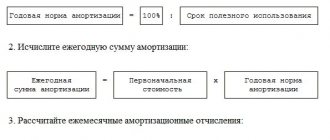Many organizations carry out work on their fixed assets that is of a capital nature: completion, additional equipment, reconstruction, modernization, technical re-equipment[1]. The cost of these works by virtue of clause 5 of Art. 270 of the Tax Code of the Russian Federation cannot be written off at once. She, according to paragraph 2 of Art. 257 of the Tax Code of the Russian Federation, increases the initial cost of the OS.
Modernization is often carried out in relation to objects that have been fully depreciated and whose residual value is zero. How should modernization costs be taken into account in this case, since the Tax Code does not provide special rules in this regard? You will learn about this from this article.
Collecting costs
To begin, the organization should collect all documents confirming the fact of modernization and calculate the costs.
Modernization can be carried out either with the involvement of third-party organizations or in-house. In the first case, documentary evidence of the costs incurred will be a bilateral acceptance certificate signed by the contractor.
When modernizing a fixed asset on your own, supporting documents will be requirements-invoices for the transfer of materials to the relevant department, acts for writing off materials, work orders. In this case, upon completion of the work, the organization must draw up an acceptance certificate (in one copy), which must indicate the full cost of the work performed and the date of completion.
Reflection of modernization costs in tax accounting
Opinion of the Ministry of Finance
If an organization has modernized a fixed asset that is fully depreciated and the residual value of which is zero, then, in the opinion of the Ministry of Finance, set out in Letter No. 03-03-06/1/16234 dated March 25, 2015 , after the modernization it follows:
- add the amount of costs for its implementation to the initial cost of the operating system;
- use the depreciation rates that were initially determined when the fixed asset was put into operation.
Let's explain this with an example.
Example 1
In 2015, the organization carried out the modernization of a fixed asset, which, in accordance with the OS Classification [2] to the fourth depreciation group (useful life - over five years to seven years inclusive).
The initial cost of the fixed asset at the time of its commissioning (January 2008) was 480,000 rubles. The useful life is determined as 80 months. The depreciation rate is 1.25% (1/80 month).
Depreciation was accrued from February 2008 to September 2014. Thus, by the time of modernization, the fixed asset was completely depreciated.
In March 2015, work on upgrading the OS was completed. The cost of work (excluding VAT) amounted to 360,000 rubles.
From April 2015, the organization will begin to take into account modernization costs for purposes of calculating income tax as follows.
The initial cost of the OS after modernization is 840,000 rubles. (480,000 + 360,000). The depreciation rate will be the same as at the time of putting the operating system into operation - 1.25%. Accordingly, the amount of monthly depreciation is 10,500 rubles. (RUB 840,000 x 1.25%).
The costs of modernization will be written off over 34 months at 10,500 rubles. (total 357,000 rubles), in the 35th month - a “tail” in the amount of 3,000 rubles. (360,000 - 357,000).
Let's assume that the organization has exercised its right (it is provided for in clause 9 of Article 258 of the Tax Code of the Russian Federation ) to apply a depreciation premium. Then the reflection of modernization expenses in tax accounting will look like this.
The depreciation bonus can be applied not only to expenses associated with the acquisition of fixed assets, but also to expenses incurred in cases of modernization of fixed assets and the amounts of which are determined in accordance with Art. 257 Tax Code of the Russian Federation . The size of the bonus is no more than 30% of capital investment costs for the 3rd – 7th depreciation groups and no more than 10% for the remaining depreciation groups (1st, 2nd, 8th – 10th).
In accordance with paragraph 3 of Art. 272 of the Tax Code of the Russian Federation, expenses in the form of bonus depreciation are recognized as expenses of the reporting (tax) period on which the start date of depreciation ( date of change in the original cost ) of fixed assets in respect of which capital investments were made falls. Note that this formulation indicates two different dates: the start of depreciation and changes in the original cost.
As follows from paragraph 4 of Art. 259 of the Tax Code of the Russian Federation , the start date of depreciation for an object of depreciable property is the 1st day of the month following the month in which this object was put into operation. The date of change in the initial cost is the date of completion of capital investments (putting them into operation) (see Resolution of the AS ZSO dated August 18, 2014 in case No. A75-4980/2013 ).
Thus, from paragraph 3 of Art. 272 of the Tax Code of the Russian Federation it follows that when making capital investments in existing fixed assets, the depreciation bonus is recognized as expenses in the month of change in their initial cost , that is, in the month when the capital investments were completed and put into operation, which is confirmed by the relevant document, for example an act on the acceptance and delivery of reconstructed or modernized fixed assets (see letters of the Ministry of Finance of Russia dated May 28, 2013 No. 03-03-06/1/19228 , dated December 4, 2009 No. 03-03-06/1/788 ).
Example 2
Let's use the data from example 1 with the only difference being that the organization applied a depreciation bonus for the costs incurred when upgrading the OS in the amount of 30%.
The depreciation bonus will be taken into account as part of other expenses in March 2015 (in the period in which the date of change in the original cost falls). The amount of the depreciation bonus is 108,000 rubles. (RUB 360,000 x 30%).
The organization will begin to take into account modernization costs for income tax purposes as follows.
The initial cost of the object after modernization (minus the depreciation bonus) is 732,000 rubles. (480,000 + 360,000 - 108,000).
The depreciation rate will be the same as at the time of putting the operating system into operation - 1.25%. Accordingly, the amount of monthly depreciation will be 9,150 rubles. (RUB 732,000 x 1.25%).
The costs of modernization will be written off over 39 months at RUB 9,150. (total 356,850 rubles), in the 40th month - a “tail” in the amount of 3,150 rubles. (360,000 - 356,850).
So, according to the Ministry of Finance, the costs of upgrading an OS, which has been fully depreciated and whose residual value is zero, increase the initial cost of the OS. To calculate depreciation, the same rate is applied that was initially established when the fixed asset was put into operation. One letter ( No. 03‑03‑06/1/16234 ) has already been mentioned above. A similar opinion was expressed in letters dated April 5, 2012 No. 03-03-06/1/181 , dated November 3, 2011 No. 03-03-06/1/714 , dated September 23, 2011 No. 03-03-06/2/146 . Thus, officials have not changed their opinion on this issue for several years, which cannot but please taxpayers.
The application of these recommendations by organizations in practice is also supported by arbitrators. For example, the Resolution of the Federal Antimonopoly Service of the Moscow Region dated April 23, 2012 in case No. A40-24244/11‑75‑102 [3] states the following. The issue of attributing expenses to expenses in a situation where the useful life of a fixed asset has expired, but the taxpayer nevertheless carried out its reconstruction (modernization), is not directly regulated by the Tax Code of the Russian Federation. However, this does not mean that the taxpayer in this case is generally deprived of the right to account for such expenses if they meet the general criteria established in Art. 252 Tax Code of the Russian Federation . Since, as a result of the modernization of such an operating system, it continues to remain a fixed asset, when determining the amount of depreciation, the same rate that was established when it was put into operation should be applied.
Similar conclusions were made in the Resolution of the Federal Antimonopoly Service of the Eastern Military District dated February 17, 2011 in case No. A29-6272/2007 .
If the repair provided spare parts...
It happens that after repairing a fixed asset, some suitable materials remain, and the company capitalizes them. According to financiers, this is nothing more than non-operating income that the company needs to take into account at market value. At the same time, used restored parts and assemblies used during repairs cannot be counted as returnable waste (see letters dated September 10, 2007 No. 03-03-06/1/656, dated September 15, 2005 No. 03-03-04/ 1/189). And when releasing spare parts received during repairs into production, reflect in material costs the amount that was shown in income (letter dated 06/02/2010 No. 03-03-06/1/365).
When registering spare parts remaining after repairing the OS, as well as when further using these parts for the facility’s own needs, VAT does not arise. This conclusion follows from the provisions of Article 146 of the main tax document.
What if an organization specifically purchases a used fixed asset in order to disassemble it into spare parts, and then uses these components to repair its facilities? Now this is very relevant, because progress is proceeding by leaps and bounds and spare parts for not entirely new equipment are sometimes hard to find during the day. In such a situation, according to fiscal officials, we are actually talking about spending on purchasing spare parts for repairing fixed assets. In accordance with paragraph 1 of Article 324 of the Tax Code of the Russian Federation, the cost of these components is included in the amount of expenses for such restoration of property. This means that these costs are recognized as spare parts are supplied for OS repairs (letter of the Federal Tax Service of Russia dated 04/02/2018 No. SD-4-3/ [email protected] ). Fiscal officials expressed a similar position in relation to the situation when a company immediately purchases parts for repairs - the cost of these spare parts is written off in the period when it was carried out (letter from the Federal Tax Service of the Russian Federation for Moscow dated June 21, 2010 No. 16-15 / [email protected] ) .
But there's a catch. An object to be disassembled into spare parts is purchased by the organization assembled (for a single price). How can you determine how much each of the removed parts cost? The answer is in the above-mentioned letter of 2018. According to the controllers, the company itself must determine in its accounting policy the procedure for transferring the purchase price to the cost of individual spare parts, guided by the criteria of validity and economic justification of expenses (the conclusion is based on the provisions of paragraph 1 of Article 272, Articles 313 and 252 of the Tax Code of the Russian Federation).
There is another approach
To be fair, it should be noted that in the absence of clear rules governing the procedure for writing off the costs of modernizing a fully depreciated operating system, in practice there are other options for writing off modernization costs that differ from the Ministry of Finance - for example, based on the depreciation rate established anew, and not from that norms that were determined when the fixed asset was put into operation. This is exactly what the taxpayer did, whose dispute with the tax authorities was considered by the FAS PO arbitrators ( Resolution of 02.12.2013 in case No. A12-8247/2012 ).
During the audit, the tax authority established that as of September 1, 2005, for tax accounting purposes, the residual value of the fixed asset object - the building - was zero, the useful life determined by the taxpayer for tax accounting purposes (366 months, or 30.5 years) had expired .
In 2008, the taxpayer completed the reconstruction of the building. The cost of the work amounted to about 53 million rubles. For tax accounting purposes, the useful life of the asset is set at 43 months. The company included in the expenses of the audited period the amount of accrued depreciation taking into account the specified period (which the inspectors did not agree with, insisting on calculating depreciation based on a useful life of 366 months).
The arbitrators recognized the organization was right. At the same time, they indicated that at the time of completion of the reconstruction the building was completely depreciated; its previously determined useful life for tax purposes had expired. Therefore, the company has the right to choose any method of accounting for the relevant reconstruction costs, including by calculating depreciation in a manner determined independently in accordance with Art. 258 Tax Code of the Russian Federation .
Note that such examples are rare, and an organization, if it wants to apply a similar technique, should assess its chances of success in a dispute with the tax authorities.
Rent: disputes about completed work
Disputes regarding what exactly the company carried out - repairs or reconstruction (modernization) - are also relevant for leased facilities. Let's look at a few of the most significant cases.
In Resolution No. F09-129/19 dated 03/05/2019, the AS of the Ural District decided that the leased premises had been reconstructed. After all, their official purpose has changed, new qualities have appeared. Only after these works were completed, the company was able to conduct trading activities in these premises. This means that the company mistakenly wrote off the expenses as repairs at a time.
But in the Resolution of the Arbitration Court of the Moscow District dated February 26, 2016 No. F05-1082/2016, the arbitrators indicated that the costs are aimed at the maintenance, upkeep and maintenance of the rented premises in good condition. The purpose of the objects and their technical and economic indicators remained the same. Their area, height, service life have not changed, the foundation has not been strengthened, and the walls have not been rebuilt. Therefore, there is a repair.
The tenants also won in the decisions of the AS of the Ural District dated June 27, 2017 No. Ф09-3674/17, FAS Moscow District dated December 3, 2009 No. KA-A40/12047-09-2 and dated January 11, 2007, January 18, 2007 No. KA-A40 /13128-06-2.
It also happens that companies and inspectors switch roles - the first advocate for reconstruction, and the second for repair. An illustrative example is the Resolution of the Supreme Court of the North-Western District dated October 12, 2016 No. F07-8220/2016, upheld by the Ruling of the Armed Forces of the Russian Federation dated February 13, 2017 No. 307-ES16-20124. The company considered that it incurred costs for the reconstruction and modernization of leased fixed assets. Such qualification of work gave the company the right to apply a reduced rate of income tax credited to the city budget. However, the inspectors were able to prove (including with the help of an examination) that there was a repair, thereby depriving the organization of this benefit. After all, the purpose and functional purpose of the premises upon completion of the work did not change, as did their technical indicators. The buildings at the time of concluding the lease agreements were suitable for use as a store. Work on objects (equipping them with ventilation, lighting, plumbing, etc.) does not comply with the requirements of Article 257 of the Tax Code of the Russian Federation and is not reconstruction. The tenant was unable to refute the arguments of the Federal Tax Service regarding the incorrect classification of the controversial work.
For information
The servants of Themis allowed the repair costs to be written off, even though the interdependence of the landlord and the tenant was established. After all, the reality of the operations did not raise any doubts, and no signs of dishonest behavior of the parties were identified (Resolution of the Administrative Court of the Far Eastern District dated March 29, 2018 No. F03-644/2018).
On the modernization of fixed assets, depreciation for which is calculated using increasing factors
According to paragraphs. 1 clause 1 art. 259.3 of the Tax Code of the Russian Federation in relation to depreciable fixed assets used for work in an aggressive environment and (or) increased shifts, taxpayers have the right to apply a special coefficient to the basic depreciation rate, but not higher than 2. Note that the provisions of this norm apply to depreciable fixed assets that were registered before January 1, 2014.
Suppose an organization is modernizing an asset that was registered before this date, when calculating depreciation for which a coefficient of 2 is applied. The question arises: how should modernization expenses be taken into account for tax purposes?
According to the Ministry of Finance, set out in Letter No. 03-03-06/1/1777 , after modernization of a fixed asset item registered before 01/01/2014, the organization has the right to continue to apply a special coefficient in relation to such an item until complete write-off the cost of this depreciable property.
We believe that these recommendations are also relevant for fully depreciated operating systems.





